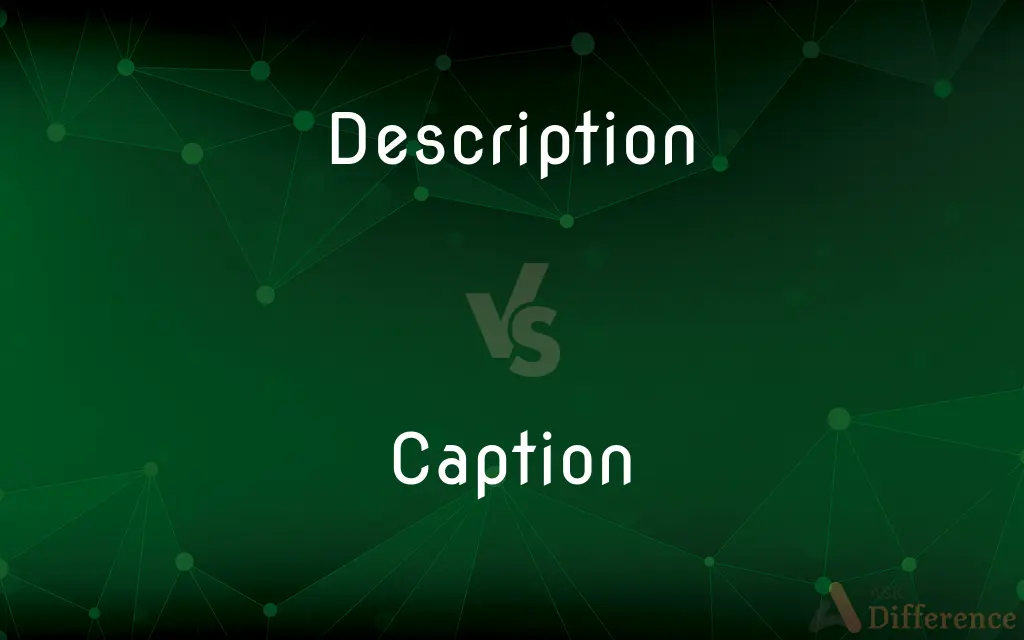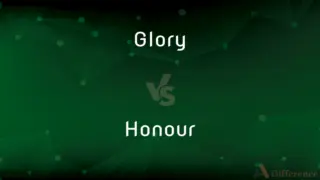Description vs. Caption — What's the Difference?
By Maham Liaqat & Fiza Rafique — Updated on April 8, 2024
A description provides detailed information or an explanation about an object, event, or concept, while a caption is a brief text that accompanies an image or illustration to explain or comment on it.

Difference Between Description and Caption
Table of Contents
ADVERTISEMENT
Key Differences
Descriptions are expansive and can range from a few sentences to multiple paragraphs, aiming to give the reader a comprehensive understanding of the subject. They might include sensory details, background information, or contextual data. For instance, a description of a painting could delve into its historical significance, the artist's background, and the emotions it evokes. Captions, on the other hand, are succinct and directly related to the visual content they accompany. They serve to clarify, add context, or provide commentary in a concise manner, such as identifying people in a photograph or explaining a graph in a textbook.
While both descriptions and captions enhance understanding, descriptions offer depth and narrative, often engaging the reader's imagination or providing critical analysis. Captions, however, focus on brevity and relevance, guiding the viewer's attention to specific details or contextualizing visual information within a larger narrative or dataset. A description of a landscape, for example, might explore its geographical features, flora and fauna, and cultural significance, whereas a caption for a photo of the same landscape might simply state the location and the date it was taken.
The choice between using a description or a caption usually depends on the medium and the intended message. Descriptions are favored in literary works, academic papers, and detailed reports, where depth of information and engagement are key. Captions are essential in visual media, such as photography, film, and graphic design, where they complement the visual content without overwhelming the viewer with text.
In digital content, descriptions and captions play distinct roles in accessibility and SEO (Search Engine Optimization). Descriptive text helps search engines understand and index content, while captions make images and videos more accessible, providing context for users who may not be able to see or interpret visual information directly.
Comparison Chart
Purpose
To provide detailed information and explanation
To offer brief explanation or comment on an image
ADVERTISEMENT
Length
Can be extensive
Usually brief and concise
Focus
Engages imagination, provides analysis
Directly tied to visual content, focuses attention
Usage Context
Literary works, academic papers, reports
Visual media (photography, film, graphics)
Accessibility
Enhances content understanding, SEO
Makes visual content accessible, aids SEO
Compare with Definitions
Description
Sensory information.
The book's description of the seaside town made you smell the salt in the air.
Caption
Brief commentary.
A witty caption on the cartoon made everyone laugh.
Description
Comprehensive account.
The report included a thorough description of the project's objectives and outcomes.
Caption
Photograph context.
The caption explained that the picture was taken during the historic peace treaty signing.
Description
Narrative detail.
Her description of the event was so vivid that listeners could almost see it.
Caption
Visual data interpretation.
The graph's caption summarized the trends in climate change data over the past decade.
Description
Analytical commentary.
The critic's description of the film explored themes of identity and memory.
Caption
Image explanation.
The caption under the photo identified the person as the city's first female mayor.
Description
Detailed explanation.
The tour guide's description of the ancient ruins brought the history to life.
Caption
Illustration note.
The diagram's caption clarified the function of each part of the machine.
Description
Description is the pattern of narrative development that aims to make vivid a place, object, character, or group. Description is one of four rhetorical modes (also known as modes of discourse), along with exposition, argumentation, and narration.
Caption
A title, short explanation, or description accompanying an illustration or a photograph.
Description
A spoken or written account of a person, object, or event
People who had seen him were able to give a description
Caption
A series of words superimposed on the bottom of television or motion picture frames that communicate dialogue to the hearing-impaired or translate foreign dialogue.
Description
A type or class of people or things
It is laughably easy to buy drugs of all descriptions
Caption
A title or heading, as of a document or article.
Description
The act, process, or technique of describing.
Caption
(Law) The heading of a pleading or other document that identifies the parties, court, term, and number of the action.
Description
A statement or an account describing something
Published a description of the journey.
Gave a vivid description of the game.
Caption
To furnish a caption for.
Description
A pictorial representation
Monet's ethereal descriptions of haystacks and water lilies.
Caption
(typography) The descriptive heading or title, of a document or part thereof.
Description
A kind or sort
Cars of every size and description.
Caption
A title or brief explanation attached to an illustration, cartoon, user interface element, etc.
Description
A sketch or account of anything in words; a portraiture or representation in language; an enumeration of the essential qualities of a thing or species.
Give a verbal description of the events
A realistic description
Caption
A piece of text appearing on screen as a subtitle or other part of a film or broadcast, describing dialogue (and sometimes other sound) for viewers who cannot hear.
Description
The act of describing; a delineation by marks or signs.
Caption
(legal) The section on an official paper (for example, as part of a seizure or capture) that describes when, where, and what was taken, found or executed, and who authorized the act.
Description
A set of characteristics by which someone or something can be recognized.
The zoo had no lions, tigers, or cats of any description.
Caption
A seizure or capture, especially of tangible property (chattel).
Description
(taxonomy) A scientific documentation of a taxon for the purpose of introducing it to science.
The type description of the fungus was written by a botanist.
Caption
To add captions to a text or illustration.
Only once the drawing is done will the letterer caption it.
Description
(linguistics) The act or practice of recording and describing actual language usage in a given speech community, as opposed to prescription, i.e. laying down norms of language usage.
Caption
To add captions to a film or broadcast.
Description
(linguistics) A descriptive linguistic survey.
Caption
A caviling; a sophism.
This doctrine is for caption and contradiction.
Description
The act of describing; a delineation by marks or signs.
Caption
The act of taking or arresting a person by judicial process.
Description
A sketch or account of anything in words; a portraiture or representation in language; an enumeration of the essential qualities of a thing or species.
Milton has descriptions of morning.
Caption
That part of a legal instrument, as a commission, indictment, etc., which shows where, when, and by what authority, it was taken, found, or executed.
Description
A class to which a certain representation is applicable; kind; sort.
A difference . . . between them and another description of public creditors.
The plates were all of the meanest description.
Caption
The heading of a chapter, section, or page.
Description
A statement that represents something in words
Caption
Taking exception; especially an quibble based on a captious argument;
A mere caption unworthy of a reply
Description
The act of describing something
Caption
Translation of foreign dialogue of a movie or TV program; usually displayed at the bottom of the screen
Description
Sort or variety;
Every description of book was there
Caption
Brief description accompanying an illustration
Caption
Provide with a caption, as of a photograph or a drawing
Common Curiosities
How should a caption be crafted for effectiveness?
A caption should be concise, directly relevant to the image or illustration, and provide necessary context or commentary.
What is the primary purpose of a description?
To provide a detailed understanding and insight into the subject, engaging the reader's senses and intellect.
Can a caption also be descriptive?
Yes, captions can include descriptive elements but within the confines of brevity and relevance to the accompanying visual.
Can descriptions be used alongside captions?
Yes, in many contexts, descriptions and captions are used together to provide both depth and clarity, especially in educational and informational materials.
How do descriptions and captions enhance accessibility?
Descriptions provide comprehensive understanding for all readers, while captions ensure visual content is accessible to those with visual impairments.
What makes a good caption in journalism?
A good journalism caption provides clear, accurate context for an image, is concise, and adheres to journalistic standards of objectivity and relevance.
Why are both descriptions and captions important in digital media?
They enhance user engagement, make content accessible, and improve SEO by providing text alternatives for visual and multimedia content.
How do descriptions contribute to storytelling?
Descriptions enrich storytelling by adding depth, context, and sensory detail, immersing the reader in the narrative.
How do descriptions and captions differ in books vs. online content?
In books, descriptions and captions are static and carefully integrated into the narrative or design. Online, they may also serve interactive or navigational purposes and contribute to searchability.
Are captions always necessary with images?
While not always mandatory, captions significantly enhance the understanding and accessibility of images, especially in informational and educational contexts.
Share Your Discovery

Previous Comparison
Glory vs. Honour
Next Comparison
Labneh vs. KefirAuthor Spotlight
Written by
Maham LiaqatCo-written by
Fiza RafiqueFiza Rafique is a skilled content writer at AskDifference.com, where she meticulously refines and enhances written pieces. Drawing from her vast editorial expertise, Fiza ensures clarity, accuracy, and precision in every article. Passionate about language, she continually seeks to elevate the quality of content for readers worldwide.















































